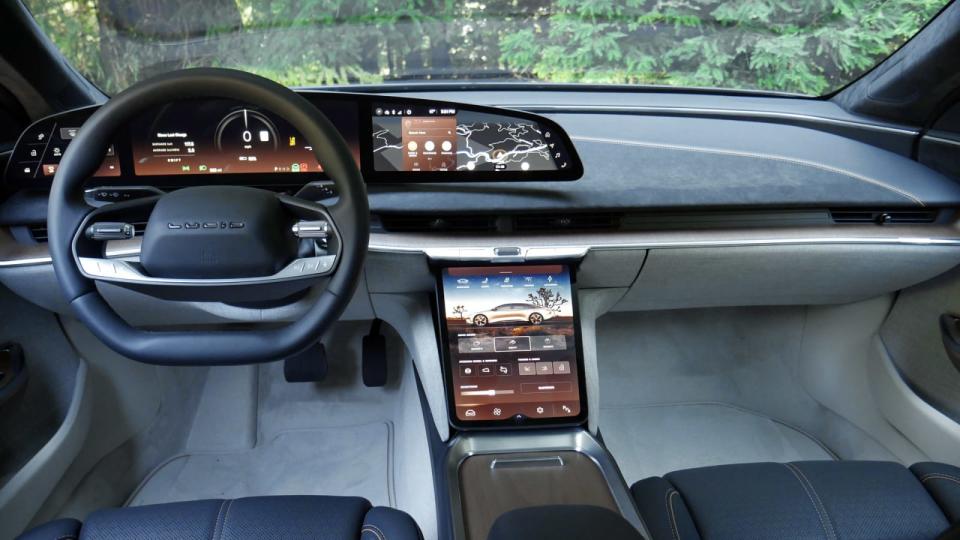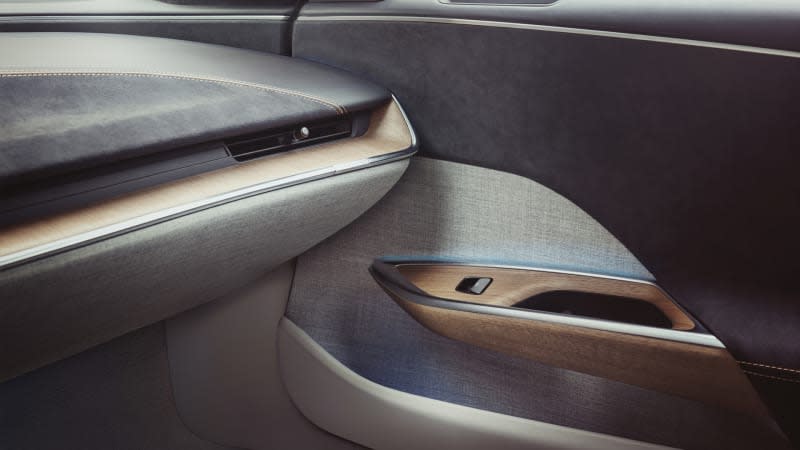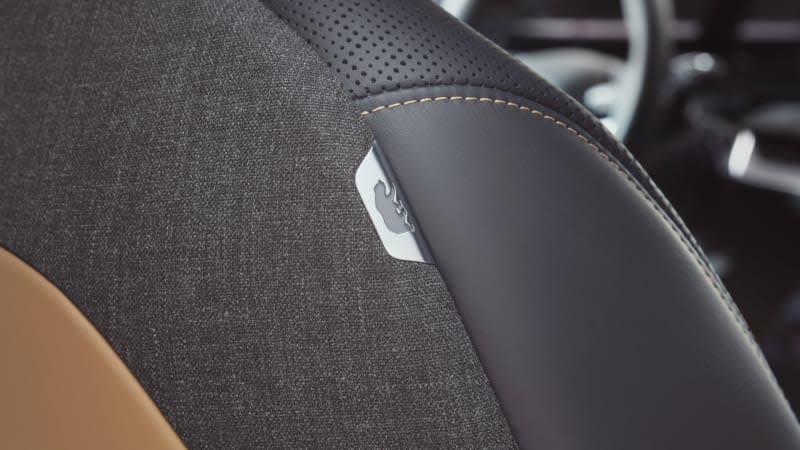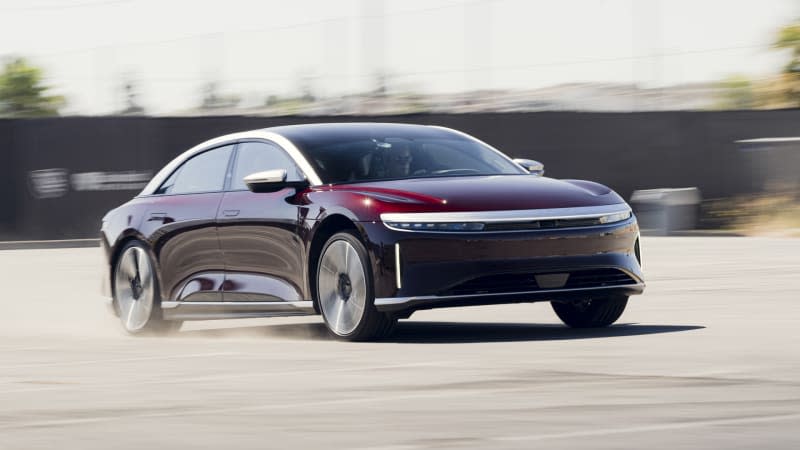Lucid Air First Drive Review: New kid in town beats everyone up

MENLO PARK, Calif. – A new car from a new company breeds a certain degree of skepticism. One expects a few rough edges, both literally and figuratively, with a few haphazard choices here and some janky elements there. Something probably won’t work. Something will almost certainly be borrowed from the parts bin of another manufacturer.
The Lucid Air manages to erase that skepticism very quickly. You climb into its driver seat to find an environment that seems perfectly familiar, and not because the switchgear and tech interface were done by some other, familiar company (they were not). There are screens aplenty, but their placement and control layout are largely similar to what you’d find in a traditional button-strewn interior. The screen to the left of the instruments in the 34-inch curved display panel controls things like lights and wipers, while the large touchscreen bridging the console and lower dash does the stuff buttons on the console and lower dash have traditionally done such as climate and drive controls. The screens are also nicely laid out with large, clear icons and minimal menus. In short, it’s easy to use. You’d think someone who used to work for Apple was in charge of it. Oh wait, he was and his name is Mike Bell.
There are still some buttons in the cabin, and they look and move with a richness that often gets missed by smaller luxury automakers (see Aston Martin). The rest of the cabin is then a treat for your eyes and fingers, with familiar elements like soft leather, faux suede and open pore wood mixing with novel elements like alpaca wool textile and a two-tone color scheme that sees the front and rear seats in different-color leather. As they say, the devil is in the details, and at least in the cars we sampled, Lucid has nailed them. This is a very expensive car, and the cabin looks and feels the part.



Like some other electric cars, there’s no start button. There are no buttons on the key fob, either. Approach the car, the door handles pop out, climb in and put your foot on the brake to tell the car you’re ready to go. The transmission selector is an electronic column shifter comparable to Mercedes’ design, but with Lucid’s own piece of hardware.
The car defaults to its “Smooth” drive mode, but will remember which of the two levels of brake regeneration you last used: Standard or High. This is the first electric car I’ve tested where the maximum regenerative brake mode was actually too strong. It was difficult to finesse the throttle enough to avoid a queasy, yo-yo tendency that’s bound to make your passengers (or you) ill. Maybe with practice it’ll be worth the extra electrons recouped, but the Standard setting is still awfully strong, allowing for one-pedal driving and coming to a complete stop by itself. The amount of automatic regenerative braking provided by Standard actually is reduced in the two sport modes, Swift and Sprint, but High remains the same across all modes. Its extreme level of braking is, perhaps paradoxically, more appreciated in the sport modes as it more closely approximates the sort of heavier braking you’d do while hustling along a mountain road.
But enough about slowing down. We start off in the Lucid Air Grand Touring Performance, a new version that closely mirrors the limited-run Dream Edition that produced 1,111 horsepower and hit 60 mph in 2.5 seconds. Lucid turned the dial down ever so slightly to maintain the Dream Edition’s supremacy for the company’s earliest of adopters, but the Performance still manages 1,050 horsepower and 921 pound-feet of torque. Yeah, those numbers are ridiculous. Why the hell was I going on about touchscreens and regenerative braking for so long?
It hits 60 mph in 2.6 seconds, and achieving it couldn’t be easier. First, put the car in Sprint mode, because the car reduces power in the other two modes for efficiency and because, dude, you don’t need 1,050 horses when driving to Whole Foods. You even have to press a “Confirm” button on the touchscreen to acknowledge you’re about to release the beast. With Sprint engaged, you can now engage Launch Control at will. Just put the brake to the floor with your left foot, the throttle to the floor with your right foot, wait a split second for a Launch Control icon to appear in the IP, and then release your left foot. Buh bye. The rest of the experience should really be accompanied by an explosion of zooming stars and a Wookiee.


Now, we also sampled the “standard” Air Grand Touring, which has 819 hp and 885 lb-ft of torque. Its 0-60 time increases to 3 seconds. Oh no. Frankly, the 0-60 times and Launch Control aren’t the best illustration of Lucid’s power-dense and brilliantly packaged motor units. All high-powered EVs benefit from the immediate torque of an electric motor, providing that neck-snap acceleration and punch-to-the-chest feeling. They must also deal with the traction limitations of rubber and pavement, which is why 1,050 hp doesn’t vaporize the doors of less powerful rivals.
As such, it’s the Lucid Air Grand Touring’s 30-50-mph thrust that’s the biggest eye opener. Or rather, you intended to go up to 50 but the car is so blindingly fast that you accidentally ended up at 100 instead. This is a car that can get you into serious trouble with law enforcement. And not just because it’s so fast, but because it utterly scrambles your sense of speed. Something like a Dodge Hellcat or Porsche 911 Turbo S provides ferocious acceleration, but it comes packaged with ferocious noise. The Lucid isn’t entirely quiet – there is some motor whine, and wind still exists – but there’s a high degree of cognitive dissonance nevertheless. And yes, this rolling start acceleration is absolutely greater than a Porsche Taycan Turbo or Audi RS e-Tron GT. A Tesla Model S Plaid? Unfortunately, I haven’t driven one of those.
Now, what about the difference between Grand Touring and the Performance variant? Can you really tell one has 231 more horsepower than the other? Ah, that’s really hard to say. The 30-50-type acceleration seemed to be slightly more vigorous, but without literally going back-to-back on the same stretch of road, it’s just a hunch at this point. Acceleration from a stop? There’s only so much nuance one can detect when your neck is being snapped and your chest compressed.

 Yahoo Autos
Yahoo Autos 
